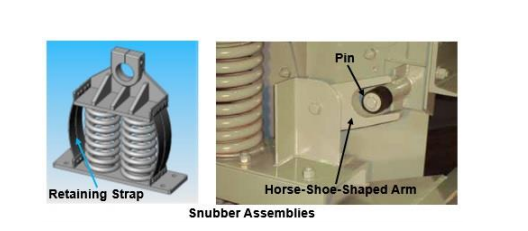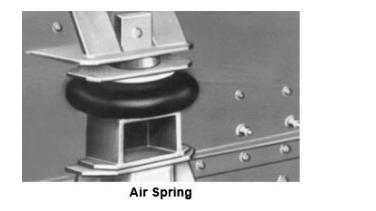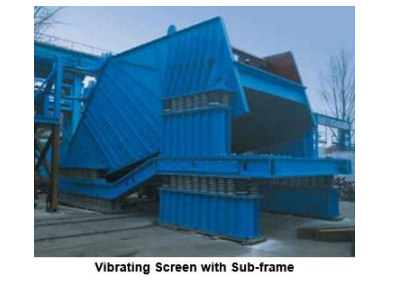many manufacturers are making all permanent joints of the screen’s body using huck bolts.

the supporting structure / foundation.

Above figure shows typical construction of two types of snubber assemblies. In case of
assembly with retaining straps, the retaining straps restrict large movements of the unit while
in the case of assembly with the spring-loaded horse-shoe-shaped arm, it comes in contact
with the pin extension to restrict the unit’s movement. However, for proper functioning of the
snubber, the spring-loaded horse-shoe-shaped arm of the snubber assembly should be snug
tightened as per manufacturer’s recommendation.
Adjustable Slope Panels
Many times inclined screens with sectioned support decks that enable the sections to be
arranged in an arc shape (banana screens) are provided with adjustable slope panels at the
feed and discharge ends. To improve the efficiency, these panels can be adjusted as per the
process requirement. Raising the feed end section will increase the velocity of the feed and
thin the depth of bed. Whereas raising the discharge end will decrease the velocity and
increase the depth of bed.
Pivoted Motor Base and Belt Tension
In case of V-belt drive, drive motor may be provided with pivoted motor base to provide
uniform belt tension at all times (to take care of belt’s normal stretch and stretch due to
start/stop bounces).
For more information on pivoted motor base, please view the article “Construction and
Working of Pivoted Motor Bases for Belt Drives” at www.practicalmaintenance.net.
Be careful. Belts that are tensioned too tightly can cause much more serious damage. If
belts are over-tightened, the vibrating frame gets pulled out of square with the support frame.
Operating in this twisted position introduces stresses that can lead to spring failure, metal
fatigue, cracking and broken welds in the vibrating frame.
In addition, the twisting will affect the stroke amplitude, thus affecting material flow and
screening efficiency.
Over-tightened belts put an extra load on the mechanism bearings that is unnecessary and
may damage motors and motor bases. Ideally, the belts should only be tight enough that
they do not slip during start-up.
Dust Enclosure
Vibrating screens are available in partially or fully enclosed models if dust or noise is a
problem, or where regulations require such control.
Air Springs

Air springs provide maximum isolation of vibration for structures supporting vibrating
screens. Their action is like that of a bellows, silently expanding or contracting with variations
of load. These air springs are made of the same rugged nylon cord and high strength rubber
used in tubeless automotive tires. Any convenient air supply can be used for inflation.
Sub-frames (Isolation Frames)

Sub-frames (additional anti-vibration frame) are used to reduce the vibrating force
transmitted to the support structure. They are highly recommended for larger screens. Above
figure shows a vibrating screen with the sub-frame.
call us :
e-mail : sales@vrvibratory.com